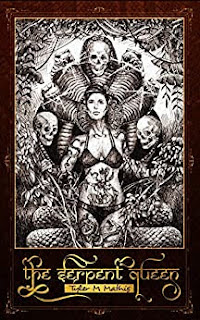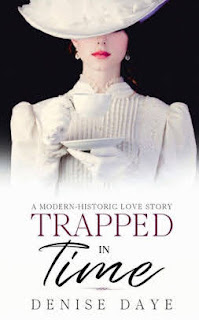Weekly Reader: Rosemary for Remembrance by Nikki Broadwell; Dark War-Torn Reincarnation Novel Reveals Struggles, Conflicts, and Love Lasts Through The Centuries
By Julie Sara Porter
Bookworm Reviews
Spoilers: In a strange bit of coincidence, Nikki Broadwell's Rosemary for Remembrance is the second book that I am reviewing in a row that has a theme of reincarnation. While the two books tell a somewhat similar story of lovers discovering that they were together in one lifetime and are in love again in the present, they couldn't be more different in their approach. Amelie Pimont's Canvas of Time is a beautiful novel of lovers torn apart in different life times and realizing that they were always fated to be together. It is idyllic and dream-like as they rediscover each other time and again and are able to go through their differences by realizing that they are meant to be.
Rosemary for Remembrance takes a far darker approach to the idea. This book seems to say that "Yes you were together and you will be together again. You will get that and all that comes with it: including the arguments, conflicts, separations, stress that you had before and get to relive it again in another life. Oh yeah and you may not have been happy the first time or this time either."
I don't want to say one is inherently better than the other, just that they certainly make you think different things about the idea of reincarnation and whether you want to spend more than one lifetime with a person.
We first encounter Rosemary and Dylan Hughes in 1957, right as they are planning to divorce. Rosemary's father has just died and the estranged couple are going through his estate. There are some hints as to the reasons behind their separation: presumed infidelity, different lifestyles, PTSD from WWII, Rosemary gaining independence, take your pick. As if that's not enough, Rosemary has waking dreams and visions of a woman in the 19th century named Rebecca and her husband, Edgar. A further twist occurs when Dylan confesses that since he came back from the war, he has had similar but foggy dreams of the same couple. The book fills into the Hughes' meeting, at times tempestuous marriage, their wartime experiences, separation, and the strange connection that they have to Rebecca and Edgar revealing that they were once them in a former life.
Rosemary for Remembrance could be considered an anti-Romance novel or maybe not so much anti-Romance as it is a realistic novel about the struggles that romance and marriage can bring. After all the books I read these two months where marriage is the be all and end all (and a couple of books where it shouldn't be), this and The Second Mrs. Thistlewood are the most thought provoking, troubling, and in some ways the best. Even Canvas of Time is lost in a haze of romantic fantasy, even more so by suggesting that love can outlast a life span and be reborn if two souls are meant for each other. Rosemary for Remembrance and The Second Mrs. Thistlewood pull the same trick that George Eliot did with Middlemarch: deconstruct a love story by getting the courtship and marriage out of the way early to give us the troubled disillusionment that occurs once the ``I Do's" have been said and the honeymoon's over. It also helps since we already know that Rosemary and Dylan are bound to be separated, even their early marital bliss is tempered with the cynicism in knowing that this marriage may not survive.
Broadwell one ups Dionne Hayes, author of The Second Mrs. Thistlewood on one aspect. Hayes shows what happens when an innocent woman is married to an abusive jerk, so all the unhappiness in the marriage is caused by one spouse who is justifiably punished for it. Broadwell's book shows that the Hughes' unhappiness is spread equally between both parties.
It's like reading about a celebrity divorce and siding with one party. Then you hear something else that makes you turn to the other side. After awhile, you think both parties are nuts and you are left hoping that they either break up permanently and move to opposite sides of the planet so they don't come anywhere near each other or realize that they are the only people crazy and stubborn enough to put up with each other, get back together, and leave the rest of us alone.
To her credit, Broadwell captures both Rosemary and Dylan rather well so their marriage is not an "either or" situation of hopeless neurotics who can't live with or without each other and make everyone else miserable in the process. They are two people who like and want different things, spend much of their time separated, and never really take the opportunity to talk out their issues.
We see some of their incompatibility begin the moment their marriage does. Dylan is a military captain hoping to marry into a wealthy family so he could move up a few notches in Washington society. Rosemary is from a wealthy family but is starting to regret the privileges that her wealth provides. She would rather take art classes than attend functions with the other officer's wives.
We also experience Rosemary suffering from the isolation when she and Dylan are assigned to the Philippines. Despite the heat, mosquitoes, and constant chit chat with the officer's wives, Rosemary gets her first real moments to shine. She learns more about the world by befriending a Filipino woman, rekindles her passion for Dylan (particularly during monsoon season), and begins to take her painting seriously.
In fact Rosemary's painting is what keeps her active and going when she returns to the States and Dylan remains to fight in the Pacific Theater. She sells her art and begins to enjoy an independent life in the country. True, she worries about Dylan and is pestered by dreams about Rebecca and Edgar. But for the first time, she is not bound by a father or husband and she likes it. When Dylan returns, he feels out of place with the New Woman that his wife has become and wants her to return to the life of an obedient military wife.
However through Dylan's struggles, we realize that he is more than an old school social climbing military man. We experience his harrowing time on the Front and as a POW. We understand why it's difficult for him to return to a life that has gone on without him, a life that he is uncertain that he wants anymore.
Dylan's time in the POW camp is the most gripping and most honest part of the book. His journal entries tell of forced marches, malaria, dysentery, and torture. Dylan is constantly surrounded by death and is torn between fearing his death and hoping for it. The prison chapters are extremely graphic and realistic depictions of war in the middle of a troubled romance and supernatural novel. There is a difference to these sections that highlight over the rest of the book and with good reason.
According to the Introduction and Acknowledgement, Broadwell used her own father's journal entries of his POW experiences during WWII with only some slight name changes. In fact, the journal is what inspired her to write the novel in the first place. Surrounding the fictionalized version of her father's wartime experiences, she created a couple unlike her parents and built a supernatural romance around them.
Dylan's time as a POW is intentionally a distraction from the rest of the book because of this real world genesis. It also gives a lot of motivation to Dylan's post war character as a man who is guarded and unwilling to recall the past. He wants to move ahead and not go back to that place.
As compelling and troubling as Rosemary and Dylan's marriage is, Rebecca and Edgar's is even more so. The two are surrounded by societal pressure and frequent separation but their incompatibility is never breached. Instead it gets wider as Edgar has an affair and fathers a child and Rebecca is later institutionalized. Unlike Pimont's Eli and Sarah, this is a couple that are not destined to be soulmates. It's not the love that lasts beyond their deaths, it's their struggles and conflicts. Those are what haunt Dylan and Rosemary, along with the troubles that they have within their own marriage.
The final third of the book that covers the aftermath of Rosemary's father's death goes in some odd directions like introducing some characters who add further complications and could have used stronger introductions (particularly one who also shares the past life with Rebecca and Edgar). It also veers towards a happy ever after with a vengeance or at least a "let's work things out" conclusion. It is kind of difficult to picture Rosemary and Dylan having a subsequent happy reunion with so many problems hanging over their heads. (In fact the book gives several good reasons why they shouldn't be.)
One could say that they recognize the fractures within their marriage and are determined not to explode the way Rebecca and Edgar did. It could also suggest not happy ever after and end of conflict forever but conversation and compromise. Recognizing their own difficulties and strengths are what help Rosemary and Dylan exorcise Rebecca and Edgar's torments once and for all.
Rosemary for Remembrance is a dark supernatural romance, one that doesn't gloss over troubles then or now. Instead, it forces characters to confront them head on as individuals before they can confront them and become a couple.









